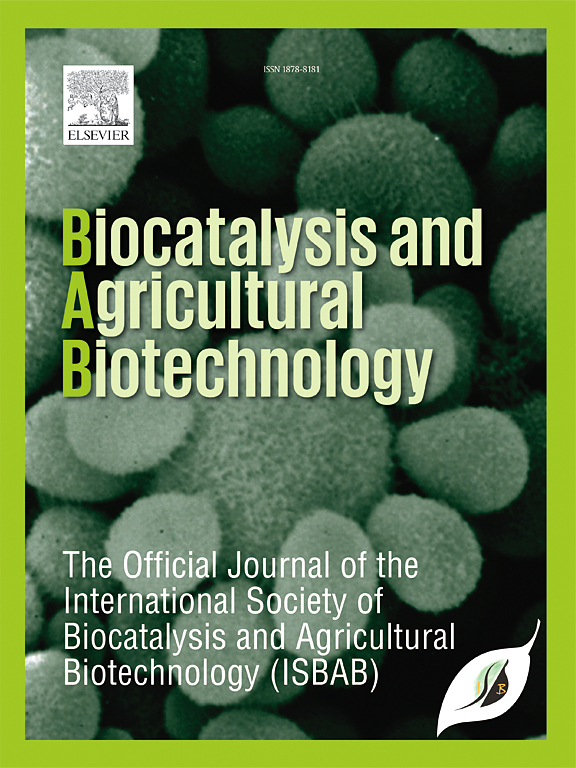Exploring the potential of seaweed as a source of lutein: A study of seasonal and spatial variation insights along the south-eastern coast of India
IF 3.4
Q2 BIOTECHNOLOGY & APPLIED MICROBIOLOGY
引用次数: 0
Abstract
Seaweed play a major role in the food, feed, fertilizer, and cosmetic industries due to their distribution worldwide with varieties, along with their distinctive nutritional and pharmaceutical properties. Lutein is a second most high-value commercial carotenoid and seaweed could serve as a potential alternative to marigold flowers, entirely avoiding freshwater footprint and fertile land-usage. The present study is a first attempt on prospecting lutein production by various seaweed collected from crucial seaweed diversity sites along the south-eastern Indian coast during all the seasons. A total of 347 seaweed including 66 different species were collected during the study period comprising the four seasons. About 102 algae were observed in the pre-monsoon, followed by post-monsoon with 90 seaweed, 78 and 77 algae in the monsoon and summer, respectively. Out of 347 seaweed, lutein yields were prominent in 126 algae belonging to Chlorophyta, 122 to Rhodophyta, and 79 to Heterokontophyta. Among all the seaweed, higher lutein yields were observed for green seaweed such as Valoniopsis pachynema (3.8 mg g−1), Ulva intestinalis (2.8 mg g−1), Caulerpa taxifolia (2.2 mg g−1), and Ulva lactuca (1.3 mg g−1); followed by red algae like Gelidium pusillum (2.1 mg g−1), and Gracilaria corticata (0.74 mg g−1). To avoid over-exploitation of natural resources, seaweed that are cultivable and rich in lutein such as species of Ulva, Caulerpa, G. pusillum and G. corticata shall be considered for large-scale cultivation either in tank-systems or rafts deployed in the open sea for production of seaweed biomass-enriched in lutein, and other valuable compounds.
海藻分布于世界各地,品种繁多,具有独特的营养和医药特性,因此在食品、饲料、肥料和化妆品行业发挥着重要作用。叶黄素是第二高价值的类胡萝卜素,海藻可作为金盏花的潜在替代品,完全避免淡水足迹和肥沃土地的使用。本研究是首次尝试探究印度东南部沿海重要的海藻多样性地点在各个季节的叶黄素产量。在四季研究期间,共采集了 347 种海藻,包括 66 个不同的物种。季风前约观察到 102 种海藻,季风后观察到 90 种海藻,季风和夏季分别观察到 78 种和 77 种海藻。在 347 种海藻中,叶黄素产量最高的是叶绿藻纲的 126 种海藻、红藻纲的 122 种海藻和异叶绿藻纲的 79 种海藻。在所有海藻中,叶黄素产量较高的是绿藻,如海带(Valoniopsis pachynema,3.8 毫克/克-1)、肠莼(Ulva intestinalis,2.8 毫克/克-1)、紫菜(Caulerpa taxifolia,2.2 毫克/克-1)和乳莼(Ulva lactuca,1.3 毫克/克-1);其次是红藻,如海带(Gelidium pusillum,2.1 毫克/克-1)和蓠芭(Gracilaria corticata,0.74 毫克/克-1)。为避免过度开发自然资源,应考虑在水槽系统或在公海上部署的筏子中大规模养殖可养殖且富含叶黄素的海藻,如莼菜、茎藻、海带和皮质海带,以生产富含叶黄素和其他有价值化合物的海藻生物质。
本文章由计算机程序翻译,如有差异,请以英文原文为准。
求助全文
约1分钟内获得全文
求助全文
来源期刊

Biocatalysis and agricultural biotechnology
Agricultural and Biological Sciences-Agronomy and Crop Science
CiteScore
7.70
自引率
2.50%
发文量
308
审稿时长
48 days
期刊介绍:
Biocatalysis and Agricultural Biotechnology is the official journal of the International Society of Biocatalysis and Agricultural Biotechnology (ISBAB). The journal publishes high quality articles especially in the science and technology of biocatalysis, bioprocesses, agricultural biotechnology, biomedical biotechnology, and, if appropriate, from other related areas of biotechnology. The journal will publish peer-reviewed basic and applied research papers, authoritative reviews, and feature articles. The scope of the journal encompasses the research, industrial, and commercial aspects of biotechnology, including the areas of: biocatalysis; bioprocesses; food and agriculture; genetic engineering; molecular biology; healthcare and pharmaceuticals; biofuels; genomics; nanotechnology; environment and biodiversity; and bioremediation.
 求助内容:
求助内容: 应助结果提醒方式:
应助结果提醒方式:


